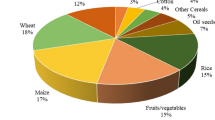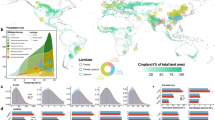Abstract
Rice-flooding fallow, rice-wheat, and double rice-wheat systems were adopted in pot experiment in an annual rotation to investigate the effects of cropping system on N2O emission from rice-based cropping systems. The annual N2O emission from the rice-wheat and the double rice-wheat cropping systems were 4.3 kg N ha−1 and 3.9 kg N ha−1, respectively, higher than that from rice-flooding fallow cropping system, 1.4 kg N ha−1. The average N2O flux was 115 and 118 μg N m−2 h−1 for rice season in rice-wheat system and early rice season in double rice-wheat system, respectively, 68.6 and 35.3 μg N m−2 h−1 for the late rice season in double rice-wheat system and rice season in rice-flooding fallow, respectively, and only 3.1–5.3 μg N m−2 h−1 for winter wheat or flooding fallow season. Temporal variations of N2O emission during rice growing seasons differed and high N2O emission occurred when soil conditions changed from upland crop to flooded rice.
Similar content being viewed by others
References
Bøckman OC & Olfs HW (1998) Fertilizers, agronomy and N2O. Nutr Cycl Agroecosyst 52: 165–170
Bronson KF, Neue HU, Singh-U & Abao EB Jr (1997) Automated chamber measurement of methane and nitrous oxide flux in a flooded rice soil: I. Residue, nitrogen, and water management. Soil Sci Soc Am J 61: 981–987
Buresh RJ & Austin RA (1988) Direct measurement of dinitrogen and nitrous oxide flux in flooded rice fields. Soil Sci Soc Am J 52: 681–687
Buresh RJ, De Datta SK, Samson MI, Phongpan S, Snitwongse P, Fagi AM & Tejasarwana R (1991) Dinitrogen and nitrous oxide flux from urea basally applied to puddled rice soils. Soil Sci Soc Am J 55: 268–273
Cai ZC, Xing GX, Shen GY, Xu H, Yan XY, Tsuruta H, Yagi K & Minami K (1999) Measurements of CH4 and N2O emissions from rice paddies in Fengqiu, China. Soil Sci Plant Nutr 45(1): 1–13
Chen GX, Huang GH, Huang B, Yu KW, Wu J & Xu H (1997) Nitrous oxide and methane emissions from soil-plant systems. Nutr Cycl Agroecosyst 49: 41–45
Davidson EA (1992) Sources of nitric oxide and nitrous oxide following wetting of dry soil. Soil Sci Soc Am J 56: 95–102
De Datta SK, Buresh RJ, Samson MI, Obcemea WN & Real JG (1991) Direct measurement of ammonia and denitrification fluxes from urea applied to rice. Soil Sci Soc Am J 55: 543–548
Duxbury JM, Harper LA & Mosier AR (1993) Contribution of agroecosystems to global climate change. In: Agricultural Ecosystem Effects on Trace Gases and Global Climate Change, pp 1–18. ASA Spec Publ 55. ASA, CSSA, and SSA, Madison, WI
Freney JR (1997) Emission of nitrous oxide from soils used for agriculture. Nutr Cycl Agroecosyst 49: 1–6
Freney JR, Denmead OT, Watanabe I & Craswell ET (1981) Ammonia and nitrous oxide losses following applications of ammonium sulfate to flooded rice. Aust J Agric Res 32: 37–45
Hansen JE, Lacis AC & Ruedy RA (1990) Comparison of solar and other influences on long-term climate. In: Schatten K & Arking A (eds) Climate Impact of Solar Variability, pp 135–145. NASA, Washington, DC
IPCC (1996) (Intergovernmental Panel on Climate Change/Organization for Economic Cooperation and Development). Guidelines for National Greenhouse Gas Inventories. OECD/OCDE, Paris
Khalil MAK, Rasmussen RA, Wang MX & Ren L (1990) Emission of trace gases from Chinese rice fields and biogas generators: CH4, N2O, CO, CO2, chlorocarbons and hydrocarbons. Chemosphere 20(91–92): 207–226
Li QK (1992) Paddy soils of China, pp 108–125, 474–490. Science Press (in Chinese)
Lindau CW, De Laune RD, Patrick WH Jr & Bollich PK (1990) Fertilizer effects on dinitrogen, nitrous oxide, and methane emissions from lowland rice. Soil Sci Soc Am J 54: 1789–1794
Minami K (1987) Emission of nitrous oxide from agro-ecosystem. Janpan Agric Res Qtly 21: 21–27
Mosier AR (1993) State of knowledge about nitrous oxide emissions from agricultural fields. Mitt Dsch Bodenkd Ges 69: 201–208
Mosier AR, Chapman SL & Freney JR (1989) Determination of dinitrogen emission and retention in floodwater and porewater of a lowland rice field fertilized with 15N-urea. Fert Res 19: 127–136
Rasmussen RA & Khalil MAK (1986) Atmospheric trace gases: Trends and distributions over the last decade. Science 232: 1623–1624
Robertson GP (1993) Fluxes of nitrous oxide and other nitrogen trace gases from intensively managed landscapes: A global perspective. In: Agricultural Ecosystem Effects on Trace Gases and Global Climate Change, pp 95–108. ASA Spec Publ 55. ASA, CSSA, and SSSA, Madison WI
Simpson JR, Freney JR, Wetselaar R, Muirhead WA, Leuning R & Denmead OT (1984). Transformations and losses if urea nitrogen after application to flooded rice. Aust J Agric Res 35: 189–200
Smith CJ, Brandon M & Patrick WH Jr (1982) Nitrous oxide emission following urea-N fertilization of wetland rice. Soil Sci Plant Nutr 28: 161–171
Stevens RJ & Laughlin RJ (1998) Measurement of nitrous oxide and di-nitrogen emissions from agricultural soils. Nutr Cycl Agroecosyst 52: 131–139
Tsuruta H, Kanda K & Hirose T (1997) Nitrous oxide emission from a rice paddy field in Japan. Nutr Cycl Agroecosyst 49: 51–58
Weiss RF (1981) The temporal and spatial distribution of tropospheric nitrous oxide. J Geophys Res 86: 7185–7195
Xing GX & Zhu ZL (1997) Preliminary studies on N2O emission fluxes from upland and paddy soils in China. Nutr Cycl Agroecosyst 49: 17–22
Xing GX (1998) N2O emission from cropland in China. Nutr Cycl Agroecosyst 52: 249–254
Xu H, Xing GX, Cai ZC & Tsuruta H (1997) Nitrous oxide emissions from three rice paddy fields in China. Nutr Cycl Agroecosyst 49: 23–28
Xu H, Xing GX, Cai ZC & Tsuruta H (1999) Effects of water regime and chemical N fertilizer application on N2O emission from paddy field. Chinese J Applied Ecology 10(2): 186–188 (in Chinese)
Author information
Authors and Affiliations
Rights and permissions
About this article
Cite this article
Xing, G., Shi, S., Shen, G. et al. Nitrous oxide emissions from paddy soil in three rice-based cropping systems in China. Nutrient Cycling in Agroecosystems 64, 135–143 (2002). https://doi.org/10.1023/A:1021131722165
Issue Date:
DOI: https://doi.org/10.1023/A:1021131722165




